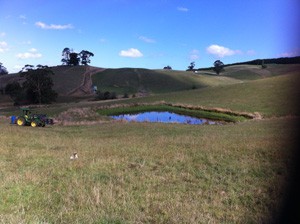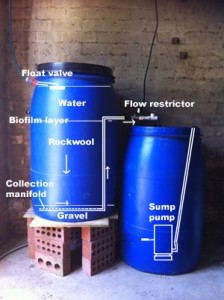Farm dam water is challenging to treat because it typically has high overall bacteria levels, is often discoloured by humic materials, has elevated turbidity and often has elevated levels of fresh organic matter.
On our dairy farm we rely on dam water through the dry months. The dam water is pumped to a holding tank near the dairy and is used as wash down water in the dairy and for drinking water for cows.

Water from a rain water tank is used to wash cows, clusters and to do the final rinse and clean. During summer the rainwater tank is occasionally topped up with the dam water. We needed a filter to treat about 1000 L each day of the dam water to improve the quality of the top up water.
Slow media filters are a simple low-tech method for treating poor quality water. We built a slow media filter out of two plastic 200 L barrels.
The main barrel has a few inches of clean gravel in the bottom. Horticultural grade rockwool was added up to about 2/3 the barrel height. The rockwool sits on a piece of woven shademesh to stop it mixing with the gravel. A manifold of PVC pipe with multiple drill holes sits within the gravel layer. It is glued to a riser pipe inside the barrel that exits just above the rockwool layer.
The filter is kept full of water by a float valve that lets in pressurised dam water. A valve on the outlet restricts the flow of water out of the filter. This both slows the flow of water in the filter and maintains a ‘head’ of water above the rockwool.

Over time a layer of microorganisms called a biofilm mainly made up by bacteria develops on the surface of the rockwool. Our filter has a biofilm surface area of 0.25 sq meters and has an output of 0.8 L each minute. Most of the work in a slow media filter is done by the biofilm layer which catches particles and digests organic material.
The second barrel catches the treated water. It has an automatic sump pump that periodically pumps the treated water out into the dairy rainwater tank. Even running at this low rate the filter treats around 1150 L each day.
The total cost of setting up the filter including fittings, rockwool and sump pump was under AU$200.
Edit: Some modifications have been made to the original setup. Additional filters have been added in parallel so they can be individually isolated for servicing. Also the barrels have been cut down to half the height so that media can be changed more easily.
References:
Guchi, Ephrem. “Review on Slow Sand Filtration in Removing Microbial Contamination and Particles from Drinking Water.” American Journal of Food and Nutrition 3.2 (2015): 47-55.